PowerPoint History. How a startup changed the presentation format
 “Speech” means a slideshow with text, images and graphics. Of course, you can get by with just words, but it is desirable to resort to visual materials. Visual elements help to remember and attract attention. And today the word “presentation” has a clear synonym - PowerPoint.
“Speech” means a slideshow with text, images and graphics. Of course, you can get by with just words, but it is desirable to resort to visual materials. Visual elements help to remember and attract attention. And today the word “presentation” has a clear synonym - PowerPoint.Of course, there are other programs that allow you to create and edit presentations. But the phenomenon that people create meaningless, boring sets of slides is called " death from PowerPoint ." We don’t call a bad writing style “death from Word”, we don’t call a calculation error “death from Excel”. PowerPoint has become the standard for visual accompaniment of speeches.
But this was not always the case. Thirty to forty years ago, the world was not as digital as it is today. Cheap personal computers just created their market. Most often, these were machines for business, not home use. Computer graphics are still making their way for ubiquitous use. At that time, life was still very analog.
')
Computers had hundreds of kilobytes of RAM, and Microsoft was a small company. Its Windows was not particularly successful, Word and Excel sold much better on Mac. If the performance required slides, the speaker did not create the slides on his own. I had to rely on the design department, which had little idea what they wanted from it. And the result was demonstrated on a kodoskop or, more rarely, on a 35 mm film.
In this strange period, saw the light of PowerPoint, not yet part of the package Microsoft Office. But first things first.
PowerPoint Presentations
The tradition to show slides during a speech originated much earlier than PowerPoint. Unless the technologies were different: they were either demonstrated on codoscopes from transparent originals, or from 35 mm films. It may seem that these are just two technologies. But they significantly determined what the performance looked like.
The typewriter was a department secretary; in the US, it was often IBM Selectric. It is typed text, charts are drawn by hand. Then a photocopy of the sheet is made on a transparent film. (Before the existence of photocopiers, the work was carried out directly on a transparent film with ink and a transparent dye.) A transparent film with text and graphics printed on it is horizontally placed on the surface of the overhead projector highlighted from below. Above, at a height of several tens of centimeters, is the optical system and a mirror. The result is projected on a vertical screen. This is one of the easiest ways to prepare and display a slide on the screen.

Eiki 3875B overhead projector with 500 watt bulb, budgetvideo.com .
Slides could look like images of 24 × 35 millimeters, which are loaded into an overhead projector , often a carousel. Images were obtained by hand-typed or typographical photographs — traditional recruitment or mini-computer workstations. At that time, mini-computers the size of cabinets were not yet superseded by personal microcomputers.
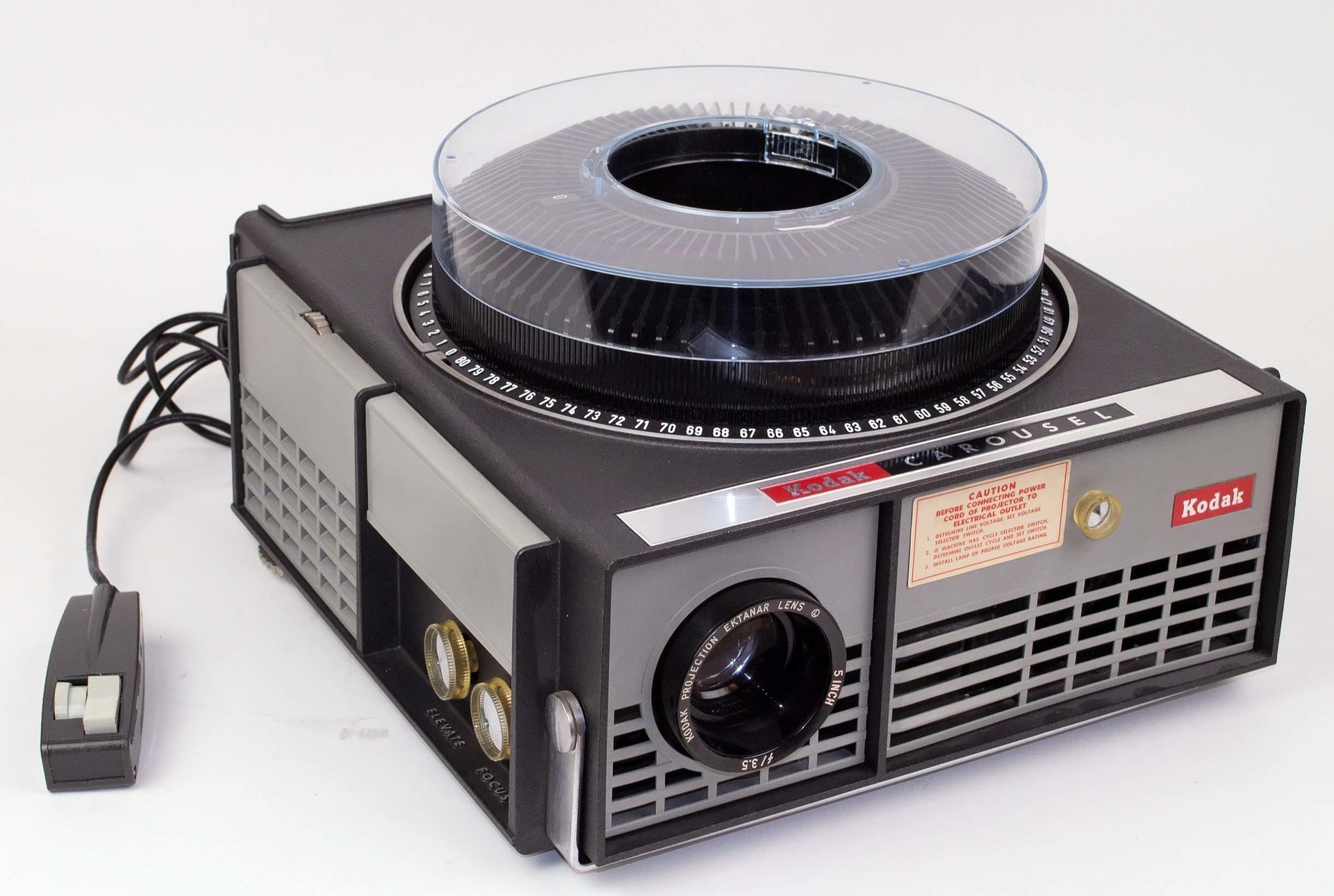
Kodak Carousel Model 550R carousel overhead projector with a 500-watt 81-slide lamp, photo by Van Eck Video Services
And there was a rare beast " multimedia ". The phenomenon is so rare that not everyone saw it. This meant the added illusion of movement using from three to a couple of dozen overhead projectors focused on the same screen. Each of the projectors had external apertures, controlled by audible signals from audiofilms that were inaccessible to human hearing. So it turned out to create a variety of transitions from slide to slide.
Today cheap and high-performance video projectors are widely available. They can do anything you want: color, movement, any animation change of slides, even a video of good resolution. The modern user does not feel the important technical limitations that have defined the format of the presentation in the past. In fact, the format of the speeches varied greatly depending on the means.
The overhead with its black and white sheets is conducive to discussions at meetings. Sheets for it is relatively easy to make, they can even be adjusted. The performance is held in a fully lit room - no need to turn off the light. The speaker sees the audience, the audience sees the speaker, there is a dialogue. Slides change one by one. If there is nothing in the overhead projector, then the screen will also be empty. So you can leave the course of speech, answer a question or just get distracted. The graphics are simple: most often it is more text. Charts are not as common.
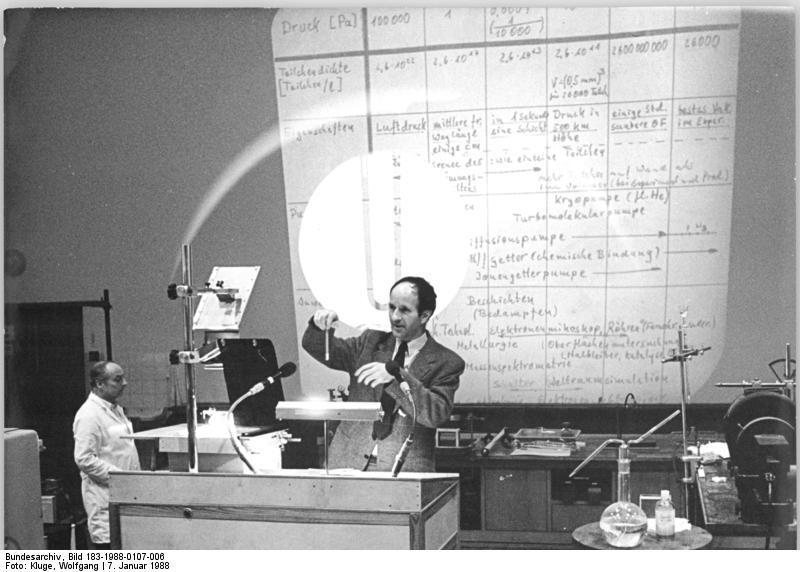
Lecture of Physics with a Codoscope, Karl Marx University (now Leipzig University).
The result was a cheap and affordable black-and-white solution for visual support. The overhead is often met at internal meetings within companies and speeches at educational institutions. Slides for him could cook himself speaker.
The 35 mm slide projector slides were in color. They had to be shown in the dark. This eliminated not only the possibility of communicating with the audience, but also any interruptions in the performance. Slides were prepared by an artist or a person with skills for working with graphics. There were drawings and beautiful design. Because of the darkness in the room, the text should have been darker than on the overhead projector. By the way, the speaker was in the dark and the opportunity to read the text from the paper was excluded. On the slide projector, the absence of a sheet in the overhead projector cannot be left on the screen - therefore, the possibility of discussion and interruption of the speaker disappears. Sometimes the speaker was highlighted on stage.
The result was a different quality of performance. More training, more entertaining, higher quality. Preparing a slide is the task of a professional or a special department. Therefore, the speaker has little control over the slide. Color is required. As a result, the slide projector appeared on speeches in front of a large audience, where there was a budget and time.
Dear “ multimedia ” presentations consisted of dozens of projectors, hundreds of slides and a well-learned script of performance. There was no talk of sudden interruptions to questions from the audience. The purpose of this was to surprise the audience with visual technology. The content faded into the background. Such high-tech performances with slides arranged in front of a large audience.
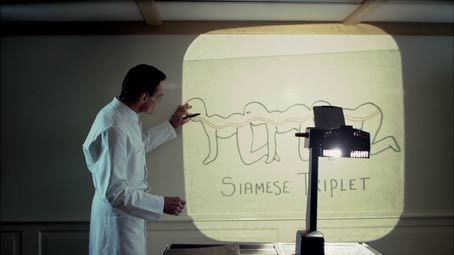
A doctor with a codoscope introduces patients to the course of a future operation, Germany.
If you go ahead, PowerPoint has mastered each of the technologies consistently. The first version, in fact, was a specialized graphic editor for creating and printing black and white slides for codoscopes. The second version learned to communicate via modem with the Genigraphics slide printing service and send samples in color. In the third one those video effects appeared - computers were connected directly to video projectors, which were rarely, but met.
In the nineties of the last century, the quality of the image of video projectors has grown to reasonable levels of use, the devices themselves have become more accessible. And the boundaries of the three genres are erased: today, users borrow elements and characteristics, insert them into their slides, without thinking about history, permissibility and taste issues.
Robert Gaskins
But all this will happen years after the events described.
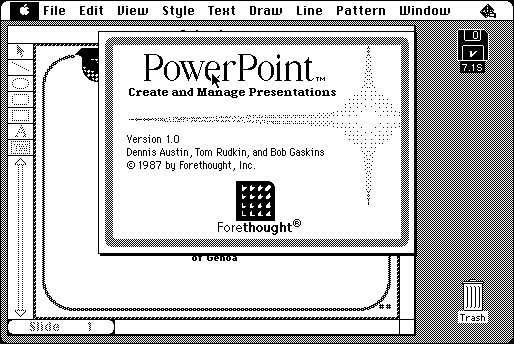
The first version of PowerPoint was released in 1987 for computers. In the screenshot of the About window there are three names and a company name. About them and should talk separately.
In 1978, Robert Gaskins, after 10 years, left the University of California at Berkeley, where he studied under a doctoral program. He will spend the next six years of his life in the research division of Bell Northern Research . You would think that both of these facts have little to do with the history of PowerPoint - because the program was developed in Forethought. In fact, the entire biography of Gaskins had a strong influence on the idea of the product.
Even before the start of work or higher education, young Robert Gaskins absorbed a good idea about photography. His father earned a photo: he sold cameras and projectors, professional and amateur photographic equipment, "audio-visual" things. It was a real family business, and as often happens, it penetrated deep into the lives of its members. Every few years, the family visited the Eastman Kodak Co. office. in Rochester in the state of New York. Later, Gaskins Sr. worked in a failed startup that tried to create a fully automatic camera, and became head of the American branch of the Japanese projector projector manufacturer EIKI , where under his leadership the purchase of Bell & Howell was made .
Among other things, the store inventories contained various materials for the manual creation of presentation materials: transparent films, transparent dyes of different colors, films for cutting into pieces, pieces of cardboard at a certain length, in order to demonstrate each item one by one. Diascopes and codoscopes, specialized and simple projectors, tools for synchronizing the work and managing the process of slideshow. Robert Gaskins grew up with free access to the equipment that was used to create presentations in the pre-computer era.
In addition, there were useful contacts. For example, when it took years later, a friend of his father, Tom Hope, provided details of his research on the size of the presentation market. Someone else in the software industry would not have that information easily.
In 1968, Robert began working on his doctoral degree in literature. But soon he became interested in the courses of the Faculty of Informatics, which at that time were not yet related to the Faculty of Electrical Engineering. So Gaskins managed to get acquainted with the language of the CDC 6400 assembler. Soon the doctoral studies were expanded to interdisciplinary, which meant combining the requirements of the doctoral departments of computer science, linguistics and English.
At the end of the sixties in Berkeley, computers still represented separate rooms of equipment. The data were entered by punch cards, the output was long sheets of folded paper. So in Berkeley, computers helped study physics and chemistry, and Gaskins studied language and literature in them. He was the chief programmer of the machine translation project, where an attempt was made to create Chinese translation techniques for English. Chinese were introduced on huge printing presses with hundreds of keys, and they were output using plotters.
Computers were not personal yet, but Robert was already thinking about it. Although many experts have long been convinced that a weak personal machine is much worse than a good time-sharing system.
Ten years later, Gaskins left school, without having written his dissertation. He defended the topic, but decided that it was much more important to run to Silicon Valley and start working on software for personal computers. At that time, Bill Gates was still writing software for Altair, Commodore PET, Tandy TRS-80, Apple II appeared on the market. Yes, the first personok had limitations. But already then many began to think about writing word processors and other means of manipulating the human language, creating spreadsheets, graphic applications and music.
At that time, Gaskins already had excellent preparation to see the idea of PowerPoint. He himself did not know this yet - many of the ideas that he had studied were considered to be of little practical scientific research. He sent his resume to companies in Silicon Valley, and saw that there was a good demand for it.
At Bell-Northern Research, Robert has not yet begun work on software, but he has seen the culture of a large organization. In particular, of the six years of Gaskins in the company, we are interested in one fact of corporate culture: both in head offices (Bell Canada and Northern Telecom), and in the company, everyone constantly used codoscopes very closely. Every day, thousands of managers resorted to slides.
For departmental reports, a markup standard was introduced, in which a footer and the actual text were placed on the sheet. For project reports, staff prepared slides according to their strict standards. For large advertisements, slides could be faxed from the head office in Canada, then transferred to film by photocopying. The local leadership changed the slides on the screen, and the voice transmitted from the central office gave a speech.
Once, Gaskins as part of a special group needed to formulate a corporate strategy for Northern Telecom (now Nortel ) on personal computers and networks. The task was to prepare recommendations for the global management of Northern Telecom in the form of slide presentations. It was an expensive event. For six months, a group of about fifteen people flew every Monday to Minneapolis to work, and flew home on Friday. Members of the group lived in apartments, they were provided with private cars. The work of each member of the group was well paid, all costs were covered. Attracted expensive research and consultants.
The work looked like this. The group gathered and discussed ideas, they were recorded on the boards. Then one of the group members sketched the future presentation slide on paper. The draft was given to the assistant, the most important person: she had an IBM Selectric typewriter with a typesetting element Orator and a photocopier access card. (Few of the group knew how to type, but some knew how, did not have access to typewriters.) Then the working group sat and talked while the assistant typed and photocopyed the slide. After studying the slide was sent for the revision of typos, positioning, protrusions and so on. The process of typing and photocopying was repeated.

By replacing a spherical dial element in an IBM Selectric typewriter, you can change the text font.
In the end, there were major leaders, there were speeches and slideshows. The group began work on the next presentation, spending such highly paid time. Even then, Gaskins thought: what if there was a system of personal computers connected to a computer network for creating slides?
Universality of language
Six months ended, Northern Telecom adopted the “office of the future” strategy, where a group of personal computers are connected by a telephone network. To do this, they bought two successful computer manufacturers Sycor and Data100 , which merged into Northern Telecom Systems Corporation. In 1983, Gaskins asked for a business trip from BNR to NTSC as part of Project Vienna. It was necessary to travel around the world and buy the best components for computers. By the way, this is how Robert first met Bill Gates when he bought MS-DOS, Word and Multiplan.
The lesson that Gaskins learned here was that the methods were the same. To purchase components, we had to travel the world, and there were presentations everywhere. Slides were in North America, in Europe and Japan. Robert even assembled a whole collection of slides, which he kept in a separate box. He was struck by how similar the basics of the style of the elements were, which hinted at the international standard of slides. Years later, he will analyze this baggage.
Computer systems
Some kind of rude slide design came up.
The Gaskins group has assembled an automated slide creation system for their own needs. The text of the slides for the overhead scanner was typed at the terminal connected to the PDP-11/70 in the Emacs text editor. Formatting needed to be done using D Eonald Knuth's T E X language. Only illustrations in T E X cannot be inserted, so they had to be drawn on the PERQ workstation in the bitmap editor. Then the text file from Emacs from the PDP-11 machine was uploaded to the DEC-20 (that is, the PDP-10 under the control of TOPS-20), on which the Stanford copy of the T E X system was running.
As mentioned above, T E X did not know how to work with pictures. Therefore, each of the images was divided into small tiles the size of a character, and in the font format T E X a pseudo font was created. Pictures were typed by these pseudo-fonts. After that, T E X to DEC-20 produced the finished file. And at this point, the user still did not see how the final result would look.
The file from T E X was drawn by the Versatec plotter. Plotter painted on a reel of granular thermal paper 11 inches wide (≈28 cm). The machine was supposed to cut the result itself into parts, but scissors were still held nearby. If there was an error somewhere, I had to return to the earliest stage of typing on Emacs on the PDP-11. Only after reaching the required level of quality by photocopying were obtained transparent slides for the overhead projector.
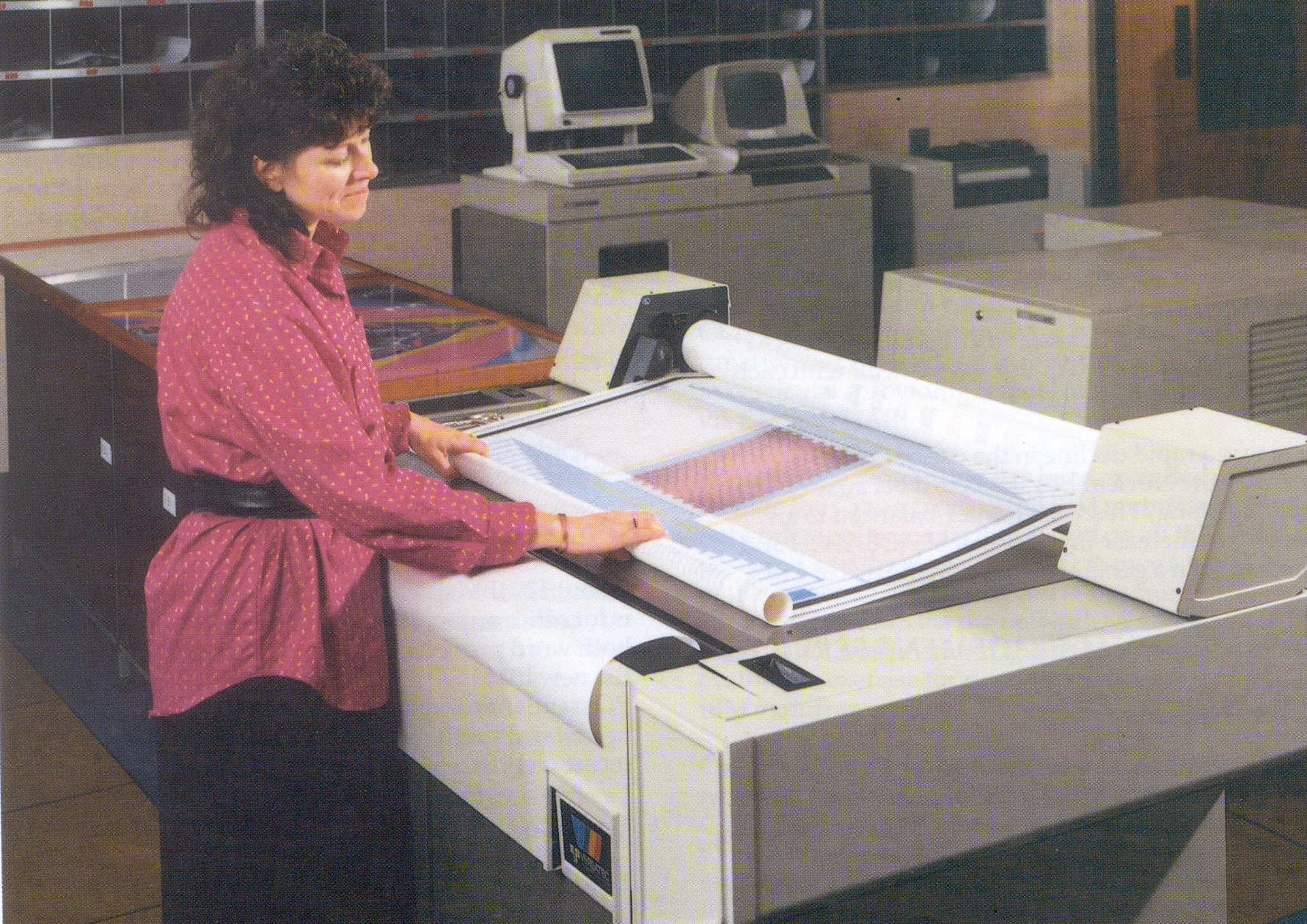
One of the color plotters of Versatec, Central Computing Annual Report Excerpt 1987 .
Alternatively, the output file could be printed on an Alphatype CRS photo dialer. Knut himself had the same system. He sometimes dropped out to use when his own was in service. The car was in a dark room, gave the pages of photographic paper, which had to be shown. The complexity of servicing this kind of thing made slides from a photosetting machine rare.
In general, the quality of the slides was higher, but it took much more time than drawing by hand. The design was a set of "crutches" worth millions of dollars. They were not specially made - it was the best thing that was done. But the most surprising thing was that other employees showed interest in it. Even large executives gathered in line for Emacs courses, Unix basics on PDP-11/70, T E X markup language, TOPS-20 operating system, Three Rivers PERQ workstation operating system and its raster editor, and other shredding level details images on pseudo-fonts. So great was the thirst for creating better slides.

Three Rivers PERQ, Computer History Museum.
Still, this strange system was not a prototype of PowerPoint. Most often, busy managers gave sketches to assist the assistants, and again they could not control the contents of the slide.
Forethought
Personal computers began to emerge in the late seventies. They did not have time to become a cheap ordinariness, but they already proved their advantage for enterprises. The market was filled with Apple II level machines (1977) and IBM PCs (1981). In the spring of 1984, the IBM PC AT came out with a powerful 286 processor, Apple tried to answer Apple III, the latter failed. The RAM of all these machines was calculated in kilobytes, the memory volume rarely exceeded one hundred kilobytes. The graphics were either black and white, or with a very limited (one) number of colors. Manufacturers competed with a set of software of their computers. For example, the spread of the spreadsheet of that time Lotus 1-2-3 worked on the IBM PC, and the Apple II was VisiCalc. Microsoft Excel will appear only in 1985.
Forethought was founded in January 1983. It was founded by two former Apple employees: Rob Campbell and Taylor Polman. The original goal was to create a GUI environment on the IBM PC platform using a high-performance monochrome accelerator - at that time it was a Hercules video card.It was supposed to write on the object-oriented technologies that were fashionable at the time, a multi-purpose application that combines work with text, graphics and spreadsheets.
If it is easier to explain the product idea, Forethought wanted to create a GUI application — modern computers interact in a similar way with the user. At that time, the personals still used symbolic graphics. Microsoft Windows did not exist yet. Focusing on graphical applications would allow a piece of a segment that has not yet existed.
December 16, 1983 Visi On, a program with a graphical interface. It had a Visi On window manager, a Word word processor, Calc and Graph spreadsheets for creating graphs. Something similar was reminiscent of the first versions of Microsoft Windows, something similar was conceived in Forethought. And Visi On itself and its creator, VisiCorp, went down in history: the program had prohibitively high system requirements for that time. Few computers at that time could boast a half-megabyte of RAM and other pleasures of life at the level of a hard disk and a good graphics card. Visi On itself did not sell well, it was scolded for its deformity and slowness of work. Visi On with Visi Calc In 1984, Microsoft announced the development of Windows over Graphical Environment Manager.
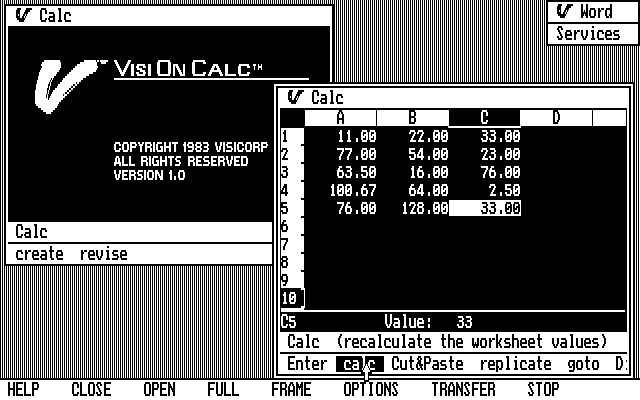
worked digital research. Behind these projects were serious players with good planning and large teams. And still, many people thought that they would not “fly up”. On January 24, 1984, Macintosh was released, which with much more modest technical characteristics (128, later 512 kilobytes of RAM, without a hard disk) successfully used a graphical interface.
Meanwhile, Forethought had no idea about software development. The company recruited a team of about a dozen programmers of various profiles and several other consultants. All written from scratch. In the list: window system, graphic file manager, graphic device drivers, proprietary user interface standard with software toolkit, database management system, integrated set of office applications. The product would have turned out to be closed: I would have to write not only a word processor (inspired by Bravo to create it ), but even fonts.
All this had to be run on MS-DOS on a standard IBM PC with a 720 × 348 monochrome green screen with a third-party Hercules video card. System requirements were higher than those of Visi On. The total cost of the components would have surpassed the failed Apple Lisa (10 thousand dollars).
Forethought hoped for some other more powerful IBM computer. But no new PCs have been announced yet. And the longer you wait for a new PC, the more likely it will be sold already bundled with Microsoft Windows.
Although there was nothing to sell, the company already hired a vice president of sales and vice president of marketing. In addition to the two founders, they made a good contribution to the burn rate.
After a few months of work, the programmers quarreled over some kind of nonsense. Therefore, some of them worked from home with a VAX machine on dial-up access, holding part of the source code hostage. Neither the founders nor anyone else had the experience to resolve this conflict.
As for investments, in January — February 1983 the first 700 thousand dollars were received. By the end of the year, another 2.5 million came. The result of the year: two million spent, another one on the account, the finished product and does not smell.
On April 25, 1984, a demonstration for investors was scheduled at Forethought. The company had literally nothing to demonstrate. Were ready only some low levels of drivers, which were called so - Foundation. At a meeting with investors had to get out.
Meet the Gaskins
April 25, 1984. With a delay in the hours of the keyboard, only the developer's fingers touch. There is nothing interesting on the screen.
Robert Gaskins visited the demonstration as an observer. His relationship with Forethought began months earlier, after the recruiter's letter was sent to the company. The first conversations with Robert took place on February 16th. But there were other famous programmers and managers in mind. There was no particular hurry, but in the end there was no one better. On April 23, the founders of Forethought introduced Robert to the pitiable condition of the product.
On the day of the demonstration, during the many hours of waiting, Robert is already presented as a kind of saving measure, as a competent expert who will correct the situation. This resulted in a small informal interview. The demonstration itself that day showed the deadlock the company faced.
Already in May, a meeting of the Board of Directors. The text was put on one of the first slides of the presentation of that day:
THE MAIN QUESTION
TO BE ELIMINATED - Special planning does not need to be SELLED - Reorganization
is required
RESTORATION - Revision of the basic plan is required
You can either close and return the remaining money to investors, or you can do something that will increase the value of the company. Fortunately, investors were positive. The choice fell on a restart. Today startups call such moments pivot, thirty years ago it was called restart.
In May and June, the founders of Forethought are preparing plans with Gaskins, although he has not yet joined the company. By early June, Robert holds meetings and consultations a couple of times a week. On July 5, Gaskins starts work as vice president of product development.
This is a strange stream of events. For saving Forethought, Gaskins fit poorly. Yes, he had programming experience at the university. But he had never before led the development of a serious product - even for internal use. In BNR, he was a manager, claimed funding, found people, but in the end all the same research projects were obtained. At Northern Telecom in Europe, he developed development strategies, but did not touch on their implementation. And Robert was already over forty, which hinted that he would hardly be able to acquire the necessary experience.
But Forethought needed at least someone who can distinguish a good programmer from a bad one. Often startups suffered from this: programmers were perceived only as a means of implementing a brilliant idea. As a result, a weak team was recruited that could not create a product, and the startup slowly bent. A good programmer can determine a good programmer, but how to find this first good programmer? They became Gaskins - knowledge in the okolographic areas of his presence. And the role played by luck and the atmosphere of despair.
On the other hand, why did Robert Gaskins get interested in such a desperate sinking ship like Forethought? His faith in the graphical interface that Gaskins shared. Forethought nevertheless had a million in the bank, and on the board of directors and among investors, extremely interesting and intelligent people. The company was interested in Robert and his ideas, she was ready to restart. He could only take it with his own idea, like a hermit crab occupying an empty shell.
Macware
Gaskins presented the restart strategy on July 19th. The company still had to deal with the software for next-generation personal computers. But the principles were changing: in addition to internal development, the sale of licensed products from third-party developers was added. Bob Gaskins in his years at Forethought At that time, software products did not have the size of today's giants, and programmers lived as writers. They independently created a masterpiece somewhere on their knees, because it did not need a lot of resources. Only then did they need the help of a large company that has the resources to polish, replicate and sell the work. Approximately in the same way, the author of the novel writes a future bestseller at home, and then delivers it to the publisher, where his work is published in millions.

That's what Forethought was going to do. The company had to learn how to create and promote software by helping other developers. At the same time, the sale of licensed products would provide cash flow for the development of its own program. By the time the product was released, Forethought should have had a proven marketing, sales, and technical support process.
In addition, Gaskins was able to convince to transfer the developed product to Windows from MS-DOS. The low-level code that was written for several months was no longer needed. Later, they tried to sell him, but to no avail. Foundation was abandoned. Even if Forethought had developed a window manager better than the upcoming Windows, the market would most likely reject it.
So, the target platform for the new product Forethought is the future Windows. But third-party programs have decided to release for Macintosh, because the work had to start immediately. Their marketing was carried out under the name MACWARE. The telephone number 1-800-MACWARE was registered, on the new business cards the word MACWARE was much larger than the small Forethought.
Powerpoint 1.0
The first version came out at the appointed time. In four days all manufactured boxes with the program were sold - 10 thousand pieces. Urgently printed new batches. Minor delays in deliveries were, but within acceptable limits. The product was so popular that it forced many to switch to a Mac. Later, Forethought was the first acquisition of a still young, but big Microsoft. Apple has already managed to invest in Forethought - this was the first investment from Cupertino.
The product was released on April 20, 1987, almost three years later, the events described. And in the summer of 1984, even before the development was very far away. These three years are not only creating a prototype, writing code and printing copies, but also a series of mistakes with a desperate struggle for the life of the company.
The old code for the failed Foundation product was no longer needed, and the development team was completely dissolved. Gaskins left only Peter Bishop, a talented programmer who had previously worked at Xerox.
Publication of other people's programs went with zeal and diligence. For the first time, employees of marketing and sales departments found something to do. By the end of July 1984, Forethought found three products that could be published. It was the Apple II FactFinder, a typing intrigue training tool for typing and a DOS-based Nushell database, which later became FileMaker . All three products were going to be released on the Macintosh. But this is only the beginning: in the MacWare portfolio, they planned to fill at least half a dozen programs.
Three months FactFinder and Typing Intrigue were being prepared for release. Forethought conducted tests, applied patches, wrote documentation and printed it, created advertisements and promotional materials, distributed them among the press, and the product among suppliers. Earned telephone technical support. FactFinder was released in October, Typing Intrigue - in November. Sales inspired optimism. In January 1985, there was a large sale of First Software, but in the future things only went down. People poorly bought "Macs" and software for them.
The money ran out by December 1984, but a large supply of First Software and a cash prepayment delayed the disaster until May.
Dennis Austin
During the focus on the MacWare brand and all its products, Gaskins worked. On August 14, a month after he started working at Forethought, he wrote a two-page plan for the program Presenter. Here it is, printed on a matrix printer. On these two pages, the future product, the size of its market niche and the required technologies for implementation are described. The knowledge of the industry and the complexity of the speakers were useful. In addition to these two pages and the ideas of Gaskins, Dennis Austin played a crucial role in the creation of PowerPoint. A well-trained specialist with broad interests, Austin worked at Burroughs, where he wrote software products and languages for the elegant and innovative B1700 mainframe. Edsger Dijkstra worked at Burroughs Corporation
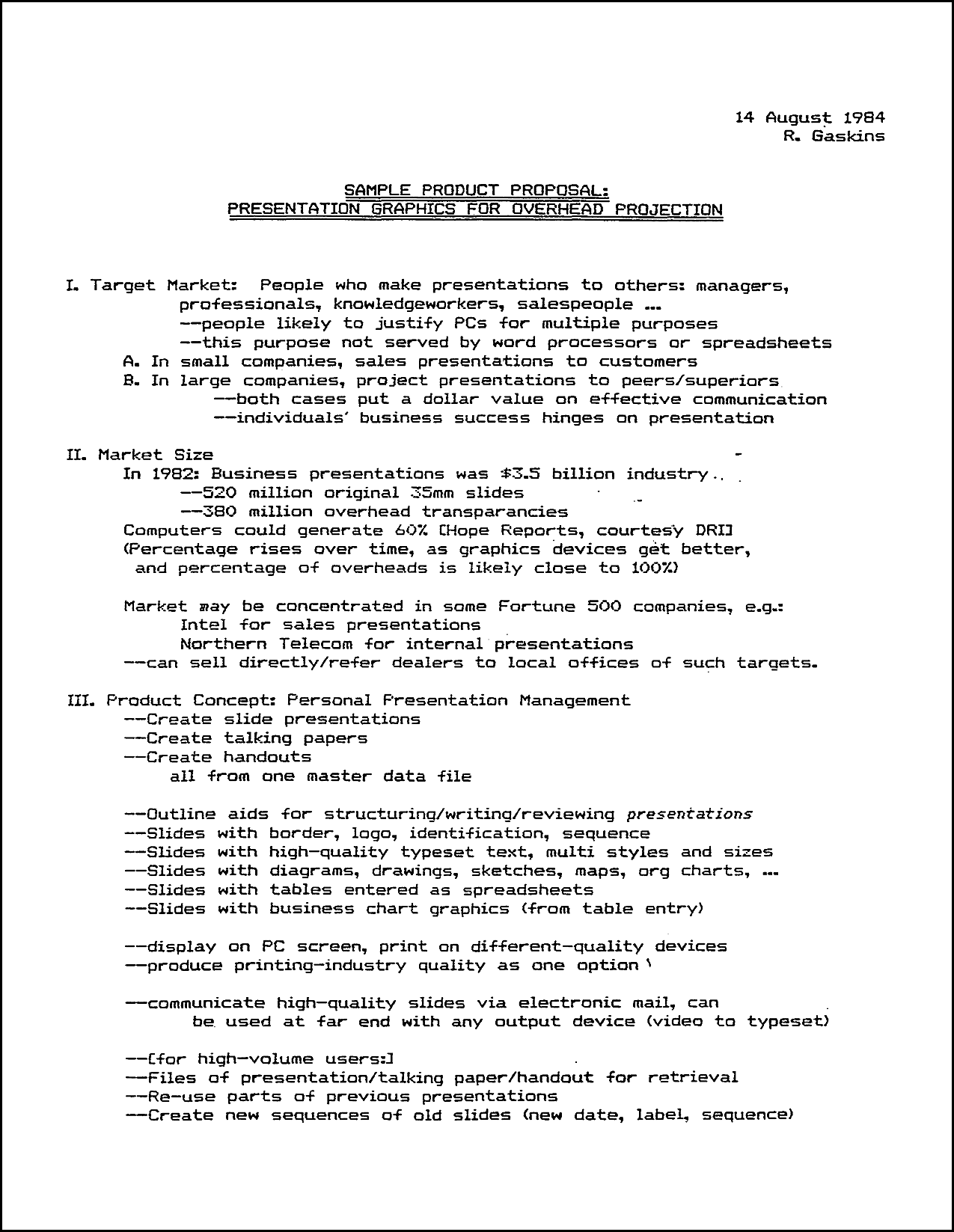
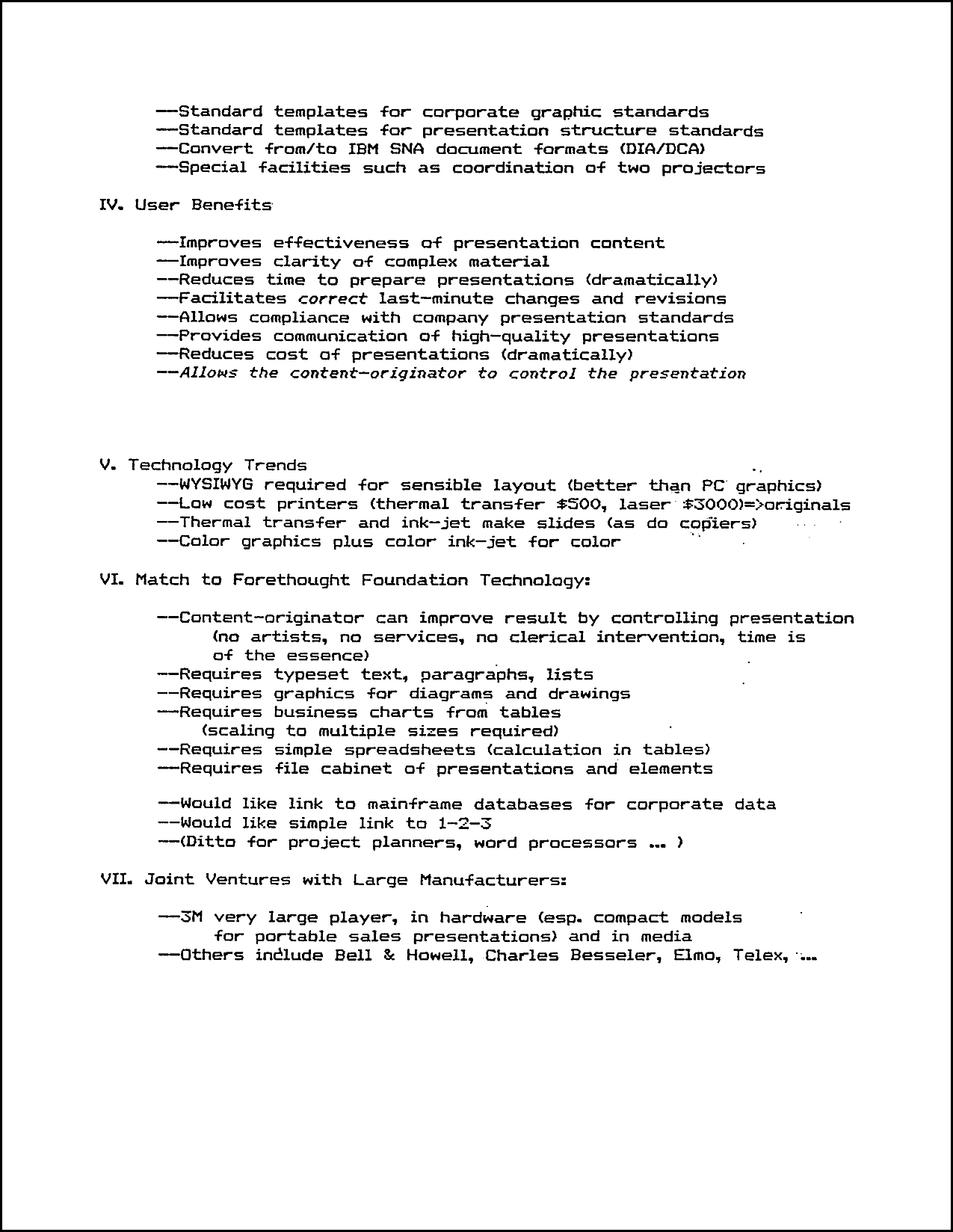
as a programmer, and occasionally attended the Austin group in Santa Barbara. Dennis Austin in the years of work at Forethought Then at Gavilan Computers, Dennis as the chief engineer helped create one of the very first laptops working on the built-in batteries. Austin has developed a software architecture and computer graphical user interface. Monochrome screen with a resolution of 400 × 64, window interface, 32 KiB of built-in RAM, a price tag of 4 thousand dollars (two times less than that of the competitor Grid Compass ) - these were excellent indicators for that time. Let Gavilan SC and showed that segment that today became laptops, but the product failed. Computer Gavilan SC was released in May 1983, and in 1985 Gavilan Computers began to make out
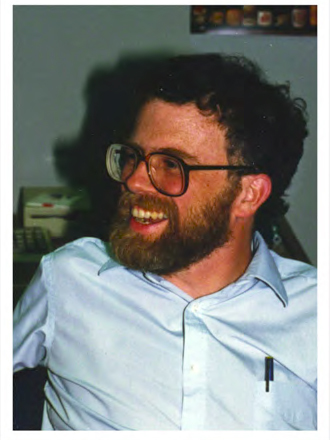
bankruptcy. In September 1984, Dennis was left without work. Gaskins tried to lure Austin back at Bell-Northern Research, but to no avail. Dennis did not believe that the leadership of BNR and NT was really going to follow the ideals of graphic personal computers. But Forethought attracted Austin with his mission. At New Enterprise Associates, a company that financed both Forethought and Gavilan Computers, which was closing at the time, was trying to dissuade them from joining a promising player. But Dennis did not listen. After interviewing Gaskins on October 22, 1984, Austin began working at Forethought, ignoring the vagueness of perspectives.
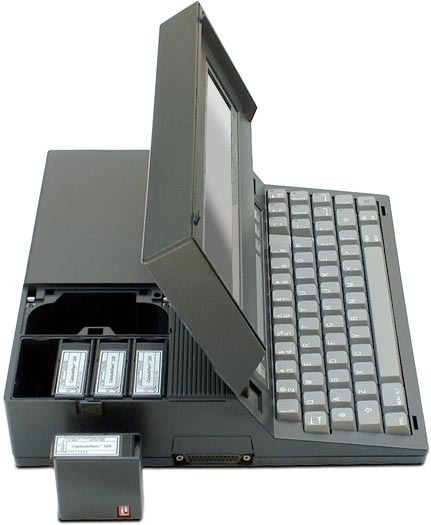
The role of Dennis was not limited only to programming. Two specialists worked for a year and a half before they were joined by others. A good half of the product ideas belong to Austin. He often thought about business issues and marketing strategies, and not just about implementation in code. Later, Dennis described the interaction with Robert as follows: "Bob built the house of his dreams, Dennis was his architect."
The first experiments with Windows
June 19, 1984 Gaskins talked with Steve Green from Microsoft, from whom he learned the internal estimates of the release date of applications on Windows. By the end of 1984, Basic, Paint and Plan were to be released, in the first quarter of 1985 - Word, File and Chart. In reality, Windows came out almost a year and a half after this conversation. Excel (another product, but, in fact, a combination of Plan and Chart) came out on Windows in 1987, Word - in 1989. At the same time, Mac Word and Excel were released in 1985, even before the start of deliveries of Windows 1.0.
As described above, Forethought targets Windows. It was on the new Microsoft Windows OS that the startup product had to be released. The low-level Foundation code written earlier was analyzed. It was tried to be ported to Windows in order to understand what needs to be thrown out of the Foundation, and what should be left. And still it was necessary to estimate Windows.
Peter Bishop, the only one of the old development team, and Dennis Austin have been doing this for several months, in parallel distracting to the duties of MacWare. In the end, Dennis came to the conclusion that the document code from the Foundation is poorly designed, and it is better to abandon the Foundation completely. And he also realized that Microsoft Windows is still very far from a good platform for developing graphic applications.
The first conclusion did not cause much surprise at Gaskins. But the second meant that the target platform would have to change: only after many years, Windows was able to adequately support graphics applications. At that time there was no necessary graphic capabilities and work with fonts.
In November 1985, Windows 1.0 still came out. In a press release, Forethought is listed as one of the developers of the software for this operating system. In fact, at that time Forethought changed course a long time ago. The presenter was supposed to go out on the Macintosh.

One of the pages of the press release. If you look at the entire list of companies from that press release, today there are only two: HP and the Apps Division of Microsoft itself. All the others either went out of business or were absorbed, usually due to poor sales. There are few successful players on this list.
In May 1985, Forethought received a new million in convertible bonds. MacWare finally released FileMaker, and it sold poorly. A couple of months later, Peter Bishop left the company. Work on the Foundation was terminated completely. Now Austin half-day officially developed Presenter. Other half a day he was engaged in technical support: Forethought continued to decline. Rob Campbell himself was engaged in marketing and sales, Gaskins took over the marketing of products in addition to his previous duties. The number of employees fell below ten.
From May 1985 to April 1986, everything was tried. Forethought considered all sorts of mergers, for example, with VisiCorp / Paladin, preparing for your own purchase, merging with UMF Systems, forming a consortium of software manufacturers for the Mac, and so on. But nothing happened. The company continued to exist, even though the closure loomed around the corner. The floundering and noticeable efforts brought 250 thousand dollars from investors in November 1985.
Macintosh
Sales of Macintosh and its software were falling, many believed that the future was for Windows. But in Forethought, from experience with 1.0, they knew that Windows was even more raw. Presenter developed for Macintosh with porting plans for Windows.
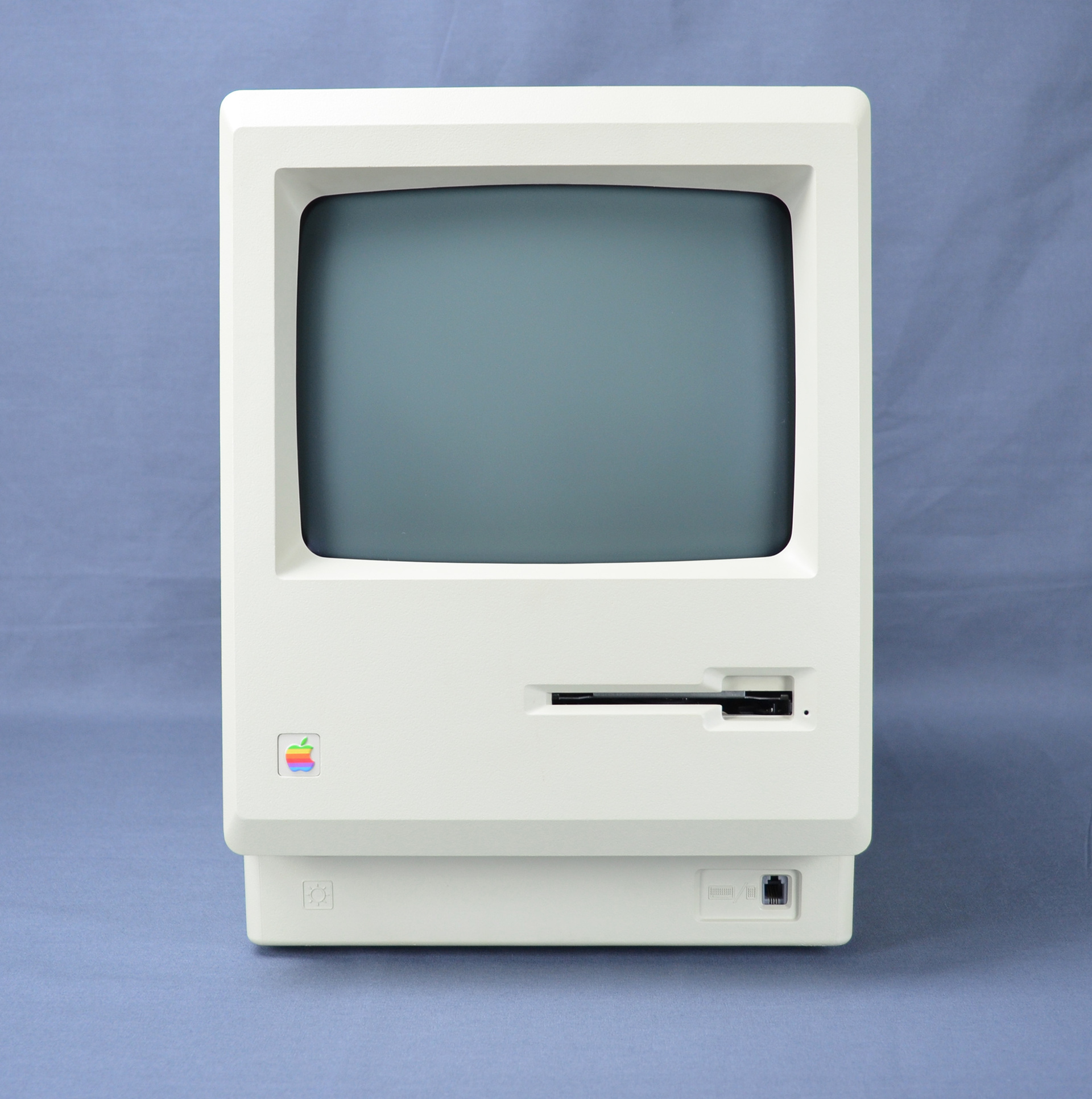
Target platform: 512 kilobytes of RAM on a 16-bit bus, Motorola 68000 processor, no hard disk, only floppy disks, black-and-white screen without grayscale resolution of 512 × 342. Macintosh 512K .
It is strange to call at that time a 16-month-old car a mature platform. But Apple took into account Lisa's errors, and the Macintosh turned out to be simple, but well-crafted. A simpler software model, a more complete and documented toolkit. An effective graphics system was easy to manage. More importantly, Macintosh had a documented text system and typography.
An Apple LaserWriter printer was connected to Macintosh. Unlike IBM PC compatible laser printers, this one was based on Adobe PostScript. This technology allowed to produce the desired level of graphics and text in a beautiful font in any size. There was a print in landscape orientation. As a result, in some places, organizations have already bought Macintosh and Apple LaserWriter and drew presentation slides in MacWrite or MacDraw. For example, Austin himself did this: while working at Gavilan, he managed to get acquainted with MacDraw and LisaDraw. This experience later influenced PowerPoint.
In addition to technological advantages were communication. Robert Campbell, as a former employee of the company, had contacts with Apple. The desktop publishing product category was born and developed, which could spur Macintosh success. “Board presentations” could be another popular category.
Competitors
Links and details from the study of his father’s friend Tom Hope helped in evaluating the free market segment of Gaskins.
Industry business presentations had a volume of 6 billion dollars. By 1990, growth was expected to reach 10 billion. These numbers include hardware, software, services, and material for 35 mm slides and overhead scopes. Audiovisual segment and filmstrips omitted. In 1985, 600 million 35 mm slides were produced, more than 500 million slides for codoscopes. The average speaker did 100 slides a year, the average marketing and sales officer gave 7–9 presentations a year with 7–10 slides each. If we divide the total numbers into average volumes, then the size of the target audience of the software of the Presenter level is millions of people.
Of the 600 million slides of 1985, only 12% were produced using a computer of any kind. The number is small, but it grew rapidly: in 1983 it was 3%, in 1978 it was only 0.1%. Most often, the slides were still done on minicomputers, rather than on personal microcomputers. As for slides for codoscopes, for 1985 only a half-percent percent was done on computers.
Only 20% of all slides used photographic images, which were difficult to process at the first personas of that time. However, it was possible not to think about photography at all: in 1985 there were no widespread digital cameras and scanners.
Surprisingly, Presenter had no competitors. There was no leader who would have to be thrown off the throne. At the same time, there was a war in other segments: Excel fought against Lotus 1-2-3, Word - against WordPerfect. There were various solutions on the market for creating graphs and charts with prices ranging from $ 400–700 per copy, but none of the products could compare with the future PowerPoint.
Development
In the analysis, Gaskins helped not only the baggage of knowledge and contacts, but also quite tangible inventory. To understand what the default Presenter styles should be and what features are needed, he examined the slide box that he collected for business trips to electronics manufacturers during his time at Northern Telecom.
In the mid-eighties, understanding the client was much more important than today. We forget that at that time the Internet did not exist in its current wealth of development. Today, you can easily reach a potential buyer, show him sketches of screenshots, demonstrate a quickly assembled prototype, find out, ask what he wants. Developers had to think more about all the details, since the feedback went on for a long time. An error in expectations was worth the life of the company. Each pixel in the Presenter outline was well thought out.
The size of the drawing surface in Presenter was chosen at 7.5 inches by 10 inches. The choice was good: it is both the aspect ratio of a typical monitor (4: 3) and Letter paper size (8.5 by 11 inches) with half-inch indents. The black and white character of the slides meant that most of the objects being drawn had no fill. For the balance, the objects needed to be arranged symmetrically or at least take into account the dimensions of the slide. For this, the reference system was placed from the center of the slide. Mobile lines helped to arrange objects.
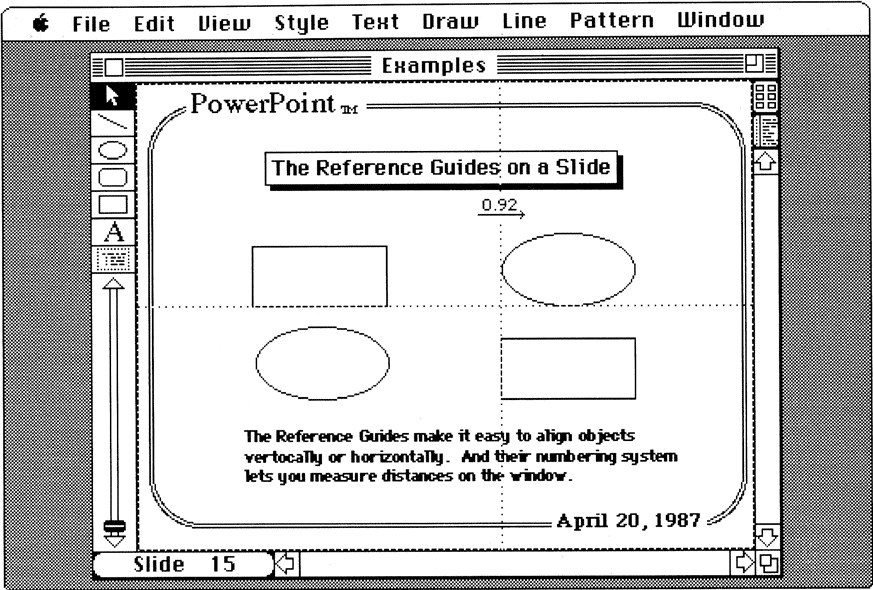
Drawing in the first PowerPoint is largely MacDraw, from which unnecessary functions have been removed. But PowerPoint was not just a drawing program. His most important "chip" was a beautiful text at the level of a good word processor. The text appeared in a separate element - a text field. The element behaved like a miniature document, with fonts, styles, line breaks, indents between lines and from the first line of a paragraph, and so on. There were multi-level lists and the necessary indents.

Another type of text was captions. There were simple signatures with formatting. Graphic elements could also contain text. He centered. Rectangles and ovals with text in the centers of the figures could create diagrams and simple tables. The text was either centered inside the figures, or, if it didn’t crawl, stuck out of them.
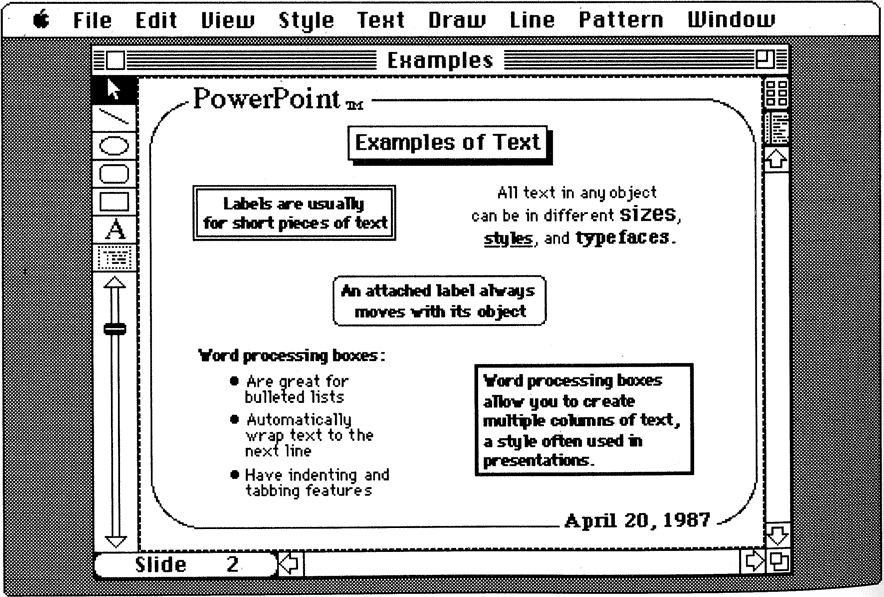
Why create a separate complex tool for graphs, if they can be done in Excel? What if a user wants to draw in MacDraw because he is more advanced? In addition to simple drawing tools, Presenter had the ability to embed pictures. This was achieved by deep support for how pictures were presented in Macintosh. On this platform, the standard defined images as vector or bitmap images with text in any location. In the picture you could imagine any visual content, and then change its size and put it in the right place on the slide.
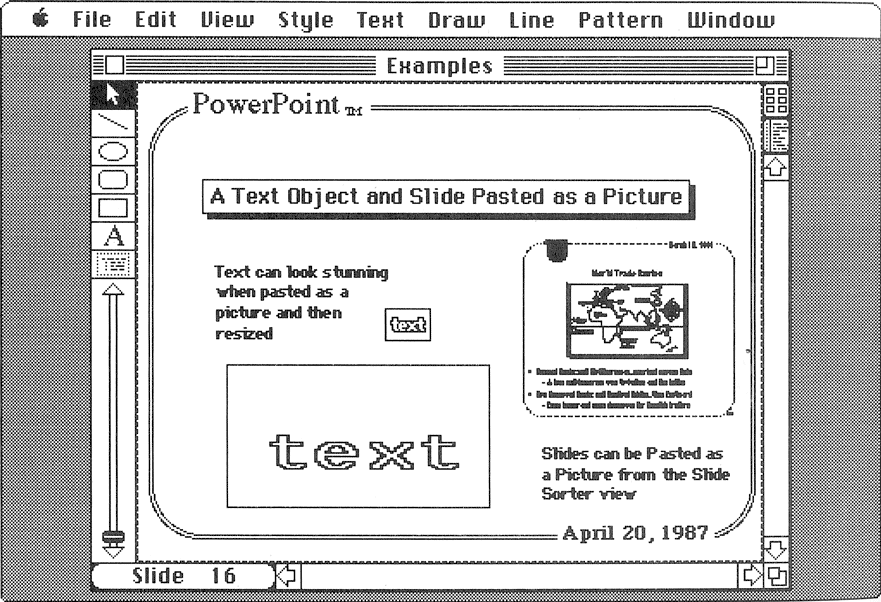
In each presentation, slides combines the unity of design, some kind of graphic theme or title. For this, a conceptual model slide was developed. He not only helped to understand where and how to place elements, but also included the same graphic backdrop in all slides. Of course, in any slide it was possible to change what was set by the model slide. Around the same time, Aldus Corporation in its PageMaker called a similar concept master page, and the name was changed to a master slide.
Sorting slides could be carried out in a special mode. In Macintosh, there was enough graphics to display thumbnail previews of all slides on one page on one screen. Slides could be deleted, copied or reordered. This function was considered important, so they put a lot of effort into its implementation. To ensure work, the program collected raster images of slides in the background. The function really was able to hit users.

The Macintosh 512K had a nine-inch screen. But the full-screen mode was still implemented: it could be useful for quick one-on-one discussions and, in the future, for large audiences on large monitors. However, the rules of the Macitntosh interface forbade hiding the top menu bar. Presenter was the first application for Macintosh, where a violation of this rule was justified. Austin had to push the idea among the Apple user interface experts. To exit the full-screen mode, the Esc key was used, which in some way set a precedent.
In addition to slides, Presenter taught how to create tips and handouts. On each of the pages in the portrait orientation of the handout, it was possible to fit two, three or six reduced copies of the slides. Similarly, we created hints: portrait orientation, a slide in half of its real size and in the other half a place for notes, where you could draw everything just like on the slide.
All this was conceived for a computer with a black and white screen. Therefore, the first version of PowerPoint made only slides for codoscopes - for them, slides were most often black and white, unlike 35 mm slides for diascopes, which were often in color.
Start of implementation
On the Macintosh, it was possible to develop using a coarse text editor and assembler provided by Apple. There were no compilers. The option is more expensive - to write on an expensive computer Apple Lisa. It had a console (not Unix, of course, but much better than MS-DOS) and a very good version of Pascal. Austin knew Pascal well. In the past, he even wrote two compilers for it.

Apple Lisa, ProFile external hard drive is not visible. A little better than the Macintosh: Motorola 68000 processor at 5 MHz, megabytes of RAM, 12-inch screen with a resolution of 720 × 360. GUIdebook .
Lisa is an expensive computer, but the impoverished Forethought already had one. Dennis brought him to his office, where the Macintosh was already on the table. He removed the partition to the neighboring cubicle and settled in comfortably. Austin had a trump Lisa with two whole hard drives, each for five megabytes. The occupied place was useful for months later, when Austin came to look at the product.
It was necessary to develop for Macintosh, a new type of personal computer. The platform was open and craved third-party software, but there should have been monotony in their interface. For this, Apple has created good tools and standards for developers, which saved time. But not everyone liked to write, as someone else pointed out. In the Forethought gathered not avid specialists with their views. On the contrary, there were hopes not only to save time, but also to become an example that Apple will demonstrate as good software that needs to be emulated.
Austin began writing the future presenter. He implemented the basic structure of the application and simple drawing. After this, energetic work began on the textual component. The process went well, the performance of the resulting application remained at the level. Is that it was not work for one person.
In May 1986, after closing the third round of investment, Forethought received 408 thousand dollars. This added confidence to hire another developer. They became Tom Rudkin. Tom had a good education, as the lead developer at Intel, wrote ICE-85 and ICE-86, created a common command language for in-circuit emulation. He then joined Bell-Nothern Research, where he implemented several Smalltalk systems on DEC-20.
By the way, this is a funny case. Once at BNR, a demonstration was held for guests from Xerox PARC, among whom was Adel Goldberg, one of the authors of the language. Guests were shown Tom's implementations of Smalltalk-76 and Smalltalk-80. BNR did not know that Adele considered Smalltalk-80 to be a deep corporate secret. The demonstration infuriated Goldberg. Rudkin wrote the implementation of the language only on the basis of a document that someone had forgotten in the cafeteria at the Massachusetts Institute of Technology.
After BNR, Tom worked at VisiCorp, where he was involved in the Visi On project. Gaskins saw that Rudkin shared his ideas about the primacy of the graphical interface, and appreciated his strong personal qualities that allowed him to work in a startup. Like Austin and Gaskins, Rudkin was passionate about literature and writing.
With the tool for Tom figured out, he bought a second-hand Lisa. Questions caused version control - there are two developers now. The corresponding software was not at hand, so the company invented its own solution. To do this, a block of cards was hung on the wall, similar to the one used to track the reception and departure of employees to work. Only here files were tracked, not people. A card was placed in each of the branches that corresponded to each of the source files. To edit the file you had to take a card. Upon return, it should have been marked with the date and changes made. The file itself has already been copied to the network storage.
On January 16, 1986, Macintosh Plus came out, which was attended by a SCSI port and a full megabyte of RAM. The Macintosh Programmers Workbench tool worked natively on it. The hard drives were expensive, but Tom and Dennis took out two 20 MB drives. Slow Lisa were abandoned.
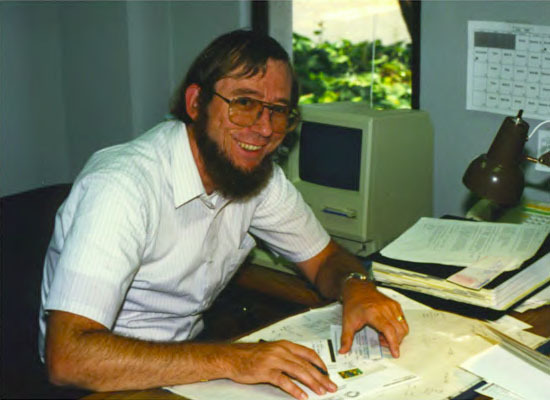
Tom Rudkin while working at Forethought. The photo was taken after the transition to Macintosh Plus.
In addition to two programmers at Forethought, the product helped develop Bear River Associates. The programmers of the latter, Tony Meadow and his partner, were already engaged in software for printing on Macintosh. In Presenter, their services were also required for the writing of the print code. On a contract basis, Tom Evslin provided code for reading ThinkTank and MORE files.
When developing it was necessary to take into account a number of features. The program used integer arithmetic to not load the processor with complex floating-point operations. Because of this, there were some unobvious weirdness. For example, there were several predefined viewing scales. But it so happened to create a quick product.
The files had to be compact: the target platform did not have a hard disk. On diskettes fit everything: from programs to files. Fortunately, the presentations did not require much space to save. Drawings and text took not so much, well consumed images: the Macintosh vector format was compact, the raster graphics required a lot of space. To avoid blow-up of file size, the pictures were stored in a pool with a pointer count. In this regard, the corresponding errors could appear.
When the presentation was open, it was completely unloaded into memory, as there was enough RAM compared to the disk. The problem was memory management. There was no virtual memory and swap. The application itself determined which segments could be moved or deleted, and the operating system managed the segments. During access, data was blocked so that the operating system did not move them. But most of the time, the data must be unlocked, so that the area of dynamic memory is not too fragmented.
There was a lot of data that Presenter allowed to be moved, but not deleted. It took a lot of time to optimize. For example, a bitmap preview of a slide for a slide sorter was drawn for a long time, and it was stored if memory was available.
The code segments were completely controlled by the operating system, but the application decided how to segment them.The developers carefully planned out the segments so that the infrequently used code could be used while the frequently used one was unloaded. An example of this is printing: with this operation, a print driver and print code were needed, and part of the GUI code could be unloaded.
CoreEdit provides basic tools for working with text and fonts. It was used only in the MacWrite word processor, and was not part of the standard toolkit. Apple allowed source code licensing in assembly language, but there was no support. Presenter should have been a high-performance text, and it is clear that it should have been written in machine language. Therefore, we chose the CoreEdit library. I just had to adapt it to work in Presenter, since CoreEdit sometimes deviated from the Macintosh standards.
In order for the slides in the slide show mode to switch quickly, you had to keep the next one in memory in the form of a bitmap image. There was enough memory for one or two such screen-sized images. It was also problematic to keep in memory the previous slide for return, but sometimes there was enough memory for it.
Presenter tried to make switching to the slide sorting mode fast. The preview for the slide sorter was drawn in the background and saved as images. There was no multitasking in the operating system, so some similarity was made in the application. When the slide was rendered in the preview, it was constantly checking for input from the user. The previews themselves took too much valuable memory, so when they needed memory, they were deleted. If free memory appeared, they were redrawn.
Apple's investment
In the meantime, the struggle for existence did not cease. Investors gave 408 thousand dollars in the third round, but said that there would be no more venture capital. It was bad news: previous money in Forethought was actively spending on shipments of FileMaker Plus, an updated version of FileMaker. There was not enough money to complete the development.
At about the same time, the xeroid invasion began. In the past, Xerox developed many graphical interface principles in Palo Alto at PARC. For ten years now, Xerox employees have been preparing presentations on their Alto. Xerox became interested in Presenter and began to offer a variety of conditions. At first it was the acquisition of rights to PowerPoint for 750 thousand dollars with a sea of various complications. At Xerox, it was believed that it would be possible to stimulate sales of their printers. Over time, the terms of the transaction were becoming crazier.
The addition of “tiny” details began: Xerox offered to make the future product colored, add support for compatibility with Harvard and Freelance documents (completely different products for DOS), make support for creating graphs and diagrams native, and not recommending the user to import from Excel. And Xerox was not interested in the Macintosh version, they wanted the Windows version to come out first. But generally their head would like Forethought to first write its product under Graphical Environment Manager (GEM), since Xerox was going to ship its IBM PC AT clone with GEM.
Unrealistic proposals began to go beyond the limits of the imaginable. Xerox representatives offered a full and exclusive transfer of rights, the purchase of a Windows version of FileMaker and more. For everything asked for a well-developed business plan. By the end of Forethought’s life, there was even an offer to purchase all exclusive marketing rights on PowerPoint for $ 18 million with a number of conditions: drivers for the Windows version for old non-graphic printers and other strange requests. Xerox intentionally offered to buy only marketing rights, leaving Forethought with the most difficult part.
Forethought spent a lot of time trying to cope with the irrepressible fantasies of Xerox, but as a result no good came of it. And just to give up Xerox was difficult, because it was one of the chances to finish the Presenter.
MacWare did not bring the flow of money. Factfinder and Typing Intrigue turned out to be small toys for the original Macintosh. FileMaker sold better. But after renegotiating contracts with the developer, Nashoba, it took him more and more deductions. MacWare was supposed to finance the development of PowerPoint. In fact, the publishing business could not reach self-sufficiency and sucked resources.
There was a constant temptation to increase the volume of published products. But this was rejected, as it would have delayed the Presenter exit. Once, several third-party developers came to Forethought and offered to add and publish an unfinished AutoCAD design program for Macintosh and Windows. This meant not only edition, but also development. Fortunately, Gaskins was smart enough not to do this: Forethought had neither the experience nor the means to publish such a complex product. Even AutoDesk itself will issue AutoCAD only eight years later, in 1993.
Gradually, Apple began to show interest in Forethought. A possible investment was already spoken about from April 1986. Apple got acquainted with the product, which was first followed by marketing support. It's easy to see why: PowerPoint in the first version was exclusive to the Mac, and Forethought needed to give the right help.
After the semi-final demonstration on January 13, 1987, representatives of Apple immediately declared that they were ready to give money. They always liked PowerPoint, they were only afraid that Forethought would not be able to finish the product. An investment of 432 thousand dollars was asked to spend on an aggressive startup program. And the money itself arrived only in March, after the start of deliveries, when there was no risk anymore. Apple's help was overdue.
Name
The first three years PowerPoint was called Presenter. There was no doubt that this name was not taken. In those years, the Internet was already. In the .com, .org., .Edu and .net zones, 115 domains have been registered. Before the advent of the Web is still far away: Tim Berners-Lee will show HTML only on August 6, 1991, the Mosaic browser will be released in 1993. It was possible to take absolutely any domain name, almost all of them were not occupied.
Program names as trademarks have not always been registered. For example, Microsoft for a long time could not register either Word, Excel or Windows. Closer to the timeline for the release of the program in Forethought, it was prudent to decide to register the name Presenter from future encroachments. An amazing thing happened at the time of application: it turned out that Presenter was already used for the presentation software of some company in New Jersey. A new name was suddenly needed: it is needed to print boxes, manuals, advertisements and promotions.
Thought lasted more than a week. MacWare published FileMaker, named by analogy with PageMaker. Why not name the product SlideMaker? As a plus, the name well described the goal, minus - the product did not slides, but entire presentations. Gaskins rejected this name.
One morning in the shower without any particular reason, the name PowerPoint came into his head. Nobody liked his proposal at work, but Robert himself got used to him more and more. Later that day, Glenn Hobin, vice president of sales, returned from a business trip. When taking off the aircraft, he saw a POWER POINT sign from the porthole, and offered it as the name of the product.
Significant coincidence and lack of time resolved the issue. Name urgently sent to lawyers. They replied that powerpoint was used in a wide class of products: from fishing rods to ballpoint pens. But no one used it for software before Forethought.

So the name appeared. In the Gaskins diaries of January 13, 1987, the product is also called Presenter during the presentation to the Apple group. January 21, in a presentation to the board of directors, this is already PowerPoint. The change occurred a month before the official announcement and three months before deliveries to customers.
Microsoft
For Apple, an investment in PowerPoint was the first in the company's history. But it happened only after the demonstration of the semi-final product. And the money itself came only in March, when the printing of new PowerPoint boxes was a problem, and not the danger of closing. When Apple decided to invest, Forethought already had a serious conversation with Microsoft.
This is not about porting to the new Windows platform, it has been discussed since mid-1984. Even then, one of Microsoft evangelists, Tani Trower, came to visit Sunnyvale in Forethought from Redmond, which showed great interest in the company. At that time, Gaskins already had an acquaintance with the top Microsoft: with Bill Gates, Scott Okey, John Shirley and others. Such contacts formed during the procurement of MS-DOS and Microsoft applications during the time of work at Bell Northern Research.
Today we know who owns PowerPoint. But that purchase was preceded by an interesting series of events. Each side knew its part of the story. If you put the puzzle pieces together, you can see what really happened.
Forethought did not know that Microsoft had two plans for the presentation market a year before. First: develop a separate program like PowerPoint. Second: add a slideshow function to Word. The first option was worked out by a small group, which developed specifications and realized that a graphic representation was needed. The second option was more accessible: most of the Microsoft products worked on computers without a graphical interface.
At that time, a similar product already existed for the Apple II - this was ThinkTank from the Living VideoText company. The program printed slides for a codoscope in the form of a structure from the title and subsequent points. She didn't know how to insert figures, pictures and graphics. There was a version of the same program for Macintosh. MORE was a little different: it only added a few beautiful things to the text, but there was still no drawing. Before PowerPoint presentations on Macintosh were most often done in MORE. By the way, this is why PowerPoint 1.0 can open ThinkTank and MORE files.
At the Esther Dyson Conference on February 22–25, 1987, Bill Gates turned to the head of Living VideoText and offered to buy the company.
In January 1987, the news came to Microsoft about the imminent announcement of the program PowerPoint. On February 6, 1987, representatives of Microsoft were shown an almost finished version of the program. February 22, the plan was a global announcement of PowerPoint. On February 27, a meeting takes place in Forethought: you need to consider the first unexpected offer. Bill Gates wanted to buy a company in cash, immediately.
Three weeks later, on March 13, 1987, at lunch in Silicon Valley, Microsoft President John Shirley voiced a well-formulated proposal: $ 5.3 million to investors, encouraging developers. Microsoft was only interested in PowerPoint, the company did not think that the rest of MacWare FileMaker Plus would be popular on Windows.
Inside, the Forethought proposal was well received. On the other hand, it would not give significant returns to investors. In addition, Forethought received two other takeover offers from Symantec and Ansa. The company decided to start selling first, and only then think about new opportunities.
On Sunday, April 12, 1987, PowerPoint went gold. The final "golden" floppy disk was ready for replication. April 20 at 16:30 there was an official exit. For a month of sales 400 thousand dollars were gained - how much and was spent on development. There were no bugs for technical support, there were more good reviews. Positive attention was in the media.
And on the first day of sales, Forethought faced two questions: financing and the next version of the product. Baer & Co. offered to go IPO and place 20% for $ 5 million with a total valuation of $ 25 million. But an IPO is a complicated thing. The company would then need a separate financial director, who would have to give up 2.5 percent of the company, and a new executive director - the other 8 percent.
On April 28, a delegation arrived from Redmond, which spent the whole day at Forethought. The sales and interest of users were discussed, PowerPoint issues on Windows were discussed.
The next day, April 29, the head of Living VideoText received a letter that Microsoft refuses to buy. On May 4, the refusal was finally issued in the form of the following letter: Forethought did not even suspect that all these months were asking about it, and that everything happened at the last moment. Microsoft followed the product, but waited for the PowerPoint delivery date. Send great reviews and sales. Then people from Redmond made sure of the correct GUI of their trip to Sunnyvale. And immediately abandoned Living VideoText - another option.

On May 13, a fax came from Randmond with a letter of intent to buy Forethought for 100,000 shares of MSFT - the very shares that jumped six times from an IPO the year before. Their market value was about 12 million dollars. Some conditions were tougher. For example, the whole Forethought on the new conditions had to be relocated to Redmond.
On May 27, a phone call was received with a new, very complex offer: 90,000 shares of the base plus bonuses. The total cost could go up to 130 thousand shares (about 14.3 million dollars at that time). The new proposal did not require relocation from Sunnyvale for one year. Difficult assessment conditions and relocation looked unattractive.
Meanwhile, Microsoft was not the only one who offered interesting terms. Forethought received merge offers with Aldus, Ansa and Symantec. Baer & Co. expressed willingness to prepare for an IPO, which investors really liked. But Microsoft shares, they said, are now at their peak, so the offer from Redmond was not fair.
On May 29, Forethought senior management met for discussion. There were four points on the board:
- Microsoft sale for 15 million dollars.
- Make some kind of deal with Xerox. [The Xeroids are not far behind.]
- IPO with an estimated $ 20 million.
- Nothing, just grow organically and slowly.
All managers, except Rob Campbell, voted for the first item. Campbell wanted a third, but after a week he changed his mind. On June 8, he announced that he wanted either Microsoft sales, or the fourth item.
As required by the terms of the takeover, Gaskins and Gates met on June 6 at 15:00. The conversation concerned a variety of technical issues, individual Forethought employees, financial indicators. The annual meeting of the board of directors was held on June 10, at which the final decision was made. There were several options: Borland was “seriously” going to buy Forethought for 18 million this week (which never happened), Xerox formed its complex offer for 18 million, IPO and so on. But it all came down to one thing: Microsoft or nothing.
On July 9, 1987, at 3 pm, an internal announcement was held at Forethought. Only in the unfinished extension to the building was a room where all the workers could fit. There were announcements. Forethought was transformed into a Graphics Business Unit, a product presentation department, and left in Silicon Valley on an ongoing basis. The same company, in which Apple invested for the first time for itself, was the first major acquisition of Microsoft. And GBU itself became the first Microsoft development center outside Redmond. The Forethought office in Sunnyvale after the takeover by Microsoft, 1987. On July 30, Microsoft and Forethought officially announced the purchase. The amount is $ 14 million in cash. Taking into account inflation, today it is about $ 30 million. In the purchase news

The New York Times newspaper writes the name of the program as Powerpoint. Today in the publication they write correctly - PowerPoint.
Powerpoint 2.0
Do not think that only Microsoft has acquired something. On the contrary, the former Forethought acquired an adult and experienced management, which coped with a company of 1200 people.
Cinderella has become a real princess. In the past, a startup resorted to outwardly strange solutions that helped save money. For example, the premises were chosen according to the months of free rent provided, according to the principles of payment, and not according to the quality of the location of office buildings. Forethought never bought a copier or fax equipment, it was always a leasing. Computer equipment was exchanged for MacWare products, which was not always the case.
Now it was the huge and fast growing Microsoft Graphics Business Unit. From office to Redmond, a 9,600 baud line was laid. A new Xenix email server has been installed. Inside the offices we got a local network. Before each workstation, Ethernet was stretched, there was a parallel network for Macintoshes.
In early 1987, the Macintosh II, a completely new machine with a relatively open platform with NuBus expansion cards, a 16 MHz Motorola 68020 processor with 386 megabytes of RAM, appeared on the market. One characteristic was important for PowerPoint: up to 256 colors on the screen. In the second version, it was necessary to realize much of what they decided to throw in the first one for speed, including color.
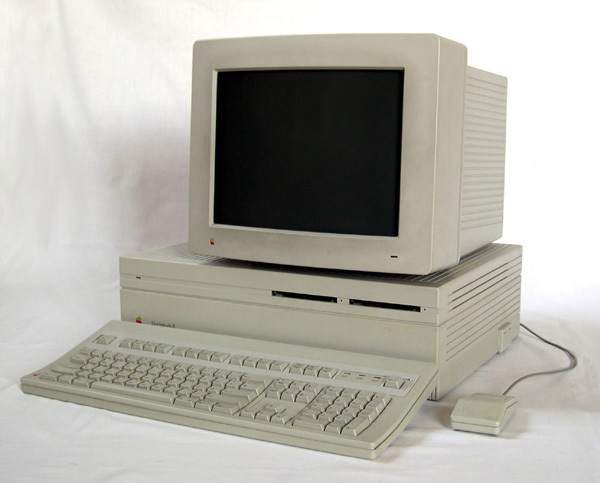
Macintosh II
The development was not standing. Dennis Austin did color PowerPoint 2.0. When developing the second version, it immediately became clear that the choice of color was a difficult task for the average user. Color collected in the "scheme", ready-made color palette, which were recommended for use. Of course, the ability to set your own colors is not forgotten.
If there is color, then this means that the program produces 35 mm slides for slide projectors. Those slides that professionals have usually done will now be made by the speakers themselves. And it was still necessary to solve the problem of making the slides themselves.
Sometimes at the Graphics Business Unit, startups would come across and offer their devices for several thousand dollars, which could expose images on film like on a printer. Exposed film was only enough to show. It was an expensive and complicated process that required a good darkroom. Not every company has a similar one.
The final solution was easier. At that time, the organization known and associated with the word “presentation” was Genigraphics. It was the brainchild of the General Electric aerospace electronics department. In the sixties, this department created for NASA a variety of visual materials for flight simulators. In the seventies, a third-party project was formed that made presentations. By the eighties, business was established. In 1986, Genigarphics received about $ 75 million in revenue. 140 artists were engaged in the production, and freelancers were hired during peak times.
In Genigraphics thought about the production of expansion cards to connect their recording devices to ordinary computers. But the equipment was too expensive for the mass sale. Another idea is to take files via modem to order, and then send the finished slides.
A large company of national scale is unlikely to be interested in some kind of startup. But now PowerPoint was released by Microsoft. In May 1988, PowerPoint 2.0 was released. As a result of several months of negotiations and cooperation, there were 5,000 sets of Genigraphics colors, examples of bureau presentations, and many other artists' efforts.
What was important for Genigraphics - the item “Send to Genigaphics” appeared in the menu. This item caused a special print driver that collected data on the desired slide production parameters, delivery address, and took a copy of the entire PowerPoint file. The driver either copied everything to a separate diskette for sending it to Genigraphics, or (learned to do it later) called the modem on the Genigraphics hot number and transmitted this data.
At the same time, Tom Rudkin tried to port the product to Windows. PowerPoint 1.0 was written in Pascal, some of the code is newer in ObjectPascal. There were proposals to translate all the code in C. It would not be too difficult, even if much would have to be rewritten. After meetings with Gates, it was decided to strive to keep the code in C and write first of all under Windows, and then port to Macintosh.
In addition to the language there were problems with the system itself and its primitiveness. The first was not able to display windows that overlap each other. The second one was released in December 1987 and looked like a target platform, but it still lacked many functions. For example, up to the third version of Windows used a monospaced system font. There were also problems of choice: for some time OS / 2 was seriously considered as a priority system.
By the first half of 1988, PowerPoint on Windows had already been transferred from Pascal to C. Separately, long work was carried out to create from scratch the replacement of Apple CoreEdit, written in 68000 assembly language.
After years of refinement, both the system and the PowerPoint 2.0 program still came out on Windows 3.0 in 1990, three years after the release on Macintosh. It is the coincidence of the delivery dates for PowerPoint 2.0 for Windows 3.0 and the OS itself that can be blamed for the growing attention to Windows.
PowerPoint 3.0 and on
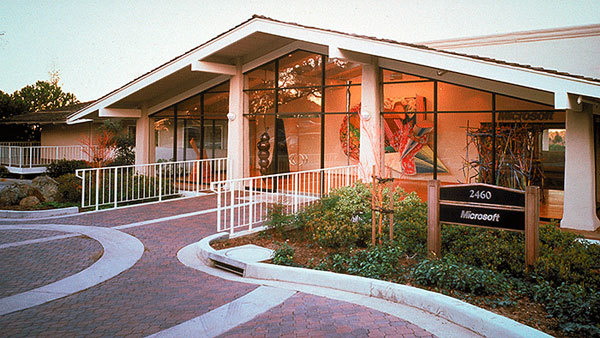
Office Graphics Business Unit, Menlo Park, California, 1993.
The third version of the program was released in May 1992 on Windows and in September of the same year on Macintosh. For the first time, supporters of the Apple camp felt like second-rate people. They had to wait four years for updates from the second version, and on Windows the new PowerPoint came out four months earlier. Already in this you can see that PowerPoint has become a full-fledged product of Microsoft, a company that has its own priorities.
The fourth version was released in August 1994. It was followed by the seventh - PowerPoint led to the numbering order of Microsoft Word. A separate program has become part of the Microsoft Office package. New users find PowerPoint exactly as a neighbor of Word, Excel and Outlook.
In the ten years since the mid-eighties, PowerPoint has unrecognizably changed the way visual materials are prepared for performances. He was one of the arguments in favor of the graphical interface and the principles of WYSIWYG. In ten years, the way the presentations show has changed beyond recognition. Codoscopes and carousel projectors today collect dust or are gently stored on the shelves of collectors. PowerPoint pictures are projected directly or shown from a large screen.
You can track the way slideshows and PowerPoint popularity using the example of one cult comic book. Here is the May 14, 1989 issue of Dilbert . Dilbert shows everything on large sheets of paper. September 17, 1991, he prepares a presentation on the computer. But the program in which it works is not named.
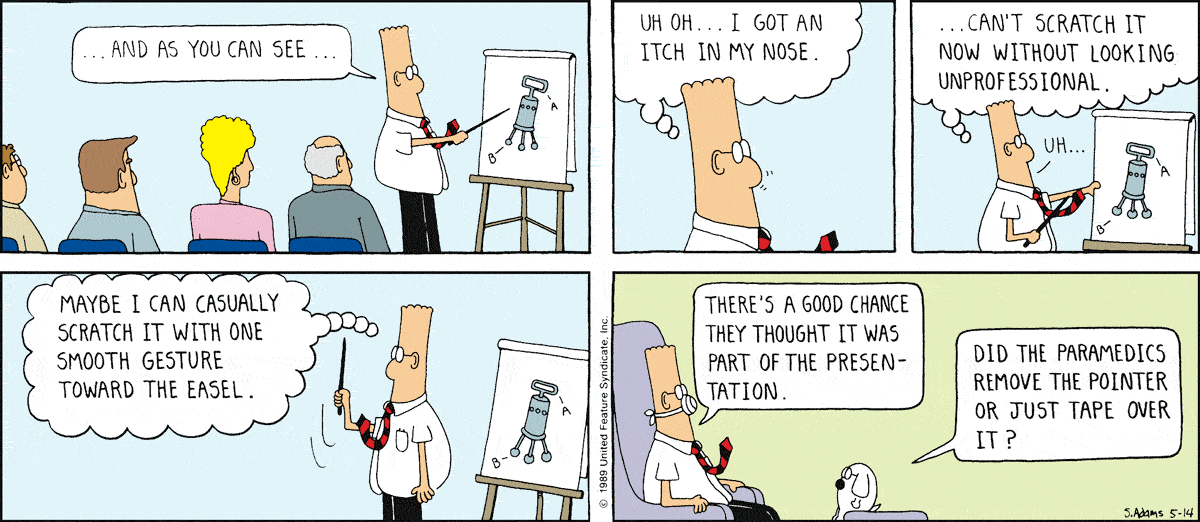

November 1, 1994 in the comic for the first time depicted overheads. There used to be projections from it in the comics, but the device itself was not depicted. Five years later, on April 30, 2000 , Dogbert gives a presentation directly from a laptop through a video projector. For this, he needed a special reflective screen: early computer projectors were dim creatures. PowerPoint itself is mentioned in quotes for the first time on June 28, 1996, and they begin to talk about it more and more. In the following, the name of this program is a synonym for not even the tool, but the presentation itself.

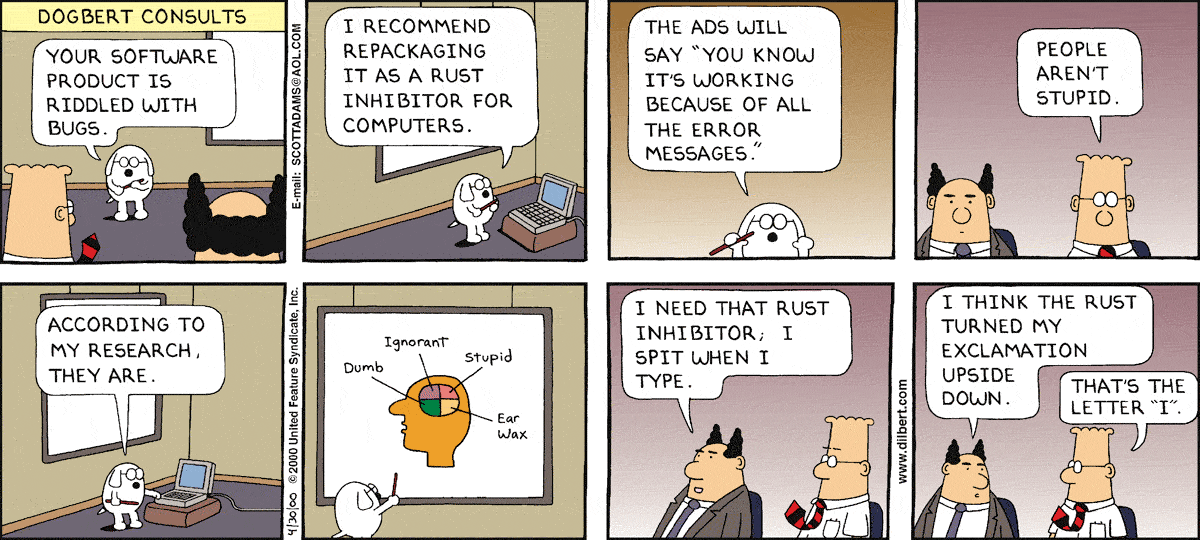
Today, the program has gone beyond the originally expected target audience. PowerPoint is used not only by some abstract office workers, but also, unexpectedly, students and their teachers, religious workers and military men during the briefing. The US military has even formed the position of PowerPoint Ranger - a man who does nothing but prepare slides.
PowerPoint made the slides publicly available. With this came boring and meaningless presentations that even describe with a special term - “death from PowerPoint”. But you can hardly blame the tool. This user often does not have the artistic talent of those who previously dealt with slides professionally. But, you see, playing Bullshit Bingo with PowerPoint is much more interesting.
What is more important, PowerPoint put the slides under the control of the speaker. Three decades later, it’s hard to imagine that other people used to be involved in their content.
Literature
- History of Forethought, Robert Gaskins, 1987;
- Beginnings of PowerPoint, Dennis Austin, 2009;
- Sweating Bullets: Notes about Inventing PowerPoint, Robert Gaskins, 2012.
Source: https://habr.com/ru/post/397787/
All Articles